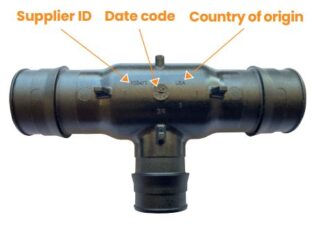By Jonathan Simon In plumbing, like many trades, knowledge is often shared plumber-to-plumber in the field. That allows experience to get passed from one generation to the next. But sometimes the information shared doesn’t keep up with new developments or, like a childhood game of “telephone,” gets distorted over time and becomes inaccurate. The result Read more
ShopTalk

By Jonathan Simon
In plumbing, like many trades, knowledge is often shared plumber-to-plumber in the field. That allows experience to get passed from one generation to the next. But sometimes the information shared doesn’t keep up with new developments or, like a childhood game of “telephone,” gets distorted over time and becomes inaccurate. The result is the proliferation of “myths” that are accepted as true by some but are provably false. Here are five myths related to CPVC plumbing systems that the FlowGuard Gold® CPVC team has encountered in the field–and the truth behind the myth.
Myth 1: CPVC should be replaced when it shows signs of discoloration
It’s easy to see how some myths get started. A plumber may think that discoloration is an indication of structural weakness, decides the pipe needs to be replaced and passes that “tip” onto a younger plumber.
But older CPVC pipes that show signs of discoloration do not need to be replaced. CPVC naturally becomes more rigid as it ages and may discolor, but these factors do not increase the risk of failure in a properly installed and serviced system. In fact, the pressure-bearing capability of CPVC pipes improves with age, so, by that measure, an older CPVC pipe is actually stronger than it was when first installed.
It is recommended that plumbers use C-style cutters, a wheel cutter, or a fine-tooth saw when servicing older CPVC pipes, but there is no reason to remove the pipe from service due to discoloration. One of CPVC’s strengths is the material’s long service life—some of the first CPVC pipes ever installed back in the 1960s are still in service today–and discoloration is not a reason to shorten that service life.
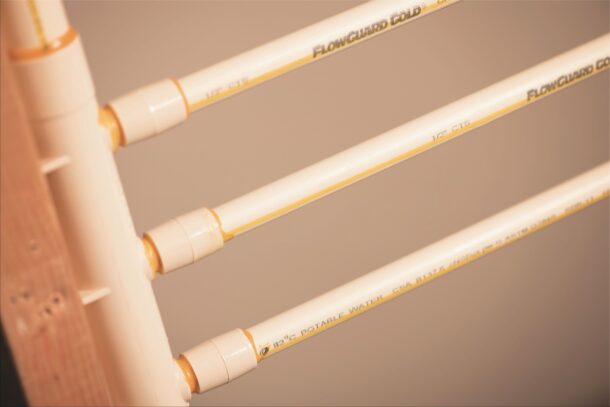
Myth 2: CPVC is difficult or slow to install
Some myths are rooted in misperceptions and false assumptions while others can be traced to competitors seeking to gain traction in a competitive market. The myth that CPVC is difficult to install falls into the second category.
CPVC plumbing systems are similar to copper in their design. Both are rigid systems that use socket-style fittings in which the pipe fits into the fitting. But CPVC is easier to work with than copper and the solvent welding process used to bond CPVC pipes and fittings is simple, easy to learn and does not require any special tools. CPVC plumbing systems install faster than copper and have installation times that compare favorably to PEX systems.
Independent research studies that measured installation times for CPVC and PEX systems found that CPVC trunk-and-branch systems install up to 17% faster than comparable PEX trunk-and-branch systems. A PEX mini-manifold system installed 10% faster than a CPVC trunk-and-branch system but used 21% more pipe and the added material costs outweighed the time savings. Most plumbers with experience using both materials have reported no noticeable speed difference between CPVC and PEX plumbing systems.
Myth 3: CPVC can’t handle higher pressures and temperatures
A review of material specifications will quickly dispel this myth. Plumbing codes require that domestic water plumbing systems be capable of handling at least 100 psi of pressure at 180°F without ballooning or bursting. FlowGuard Gold pipes and fittings not only meet this requirement but are pressure rated to 400 psi at room temperature and above 200 psi at all temperatures up to 140°F. When subjected to extreme quick-burst testing, a solvent-welded FlowGuard Gold CPVC plumbing system will not typically fail until the system reaches pressures of 1200 psi or higher.
In addition, CPVC isn’t subject to additional temperature and pressure limitations imposed by chlorinated water on other plastic plumbing systems (140° F and 80 psi). That makes CPVC ideal for higher temperature applications such as hot water lines. It can even support legionella mitigation strategies that store water above 140°F. In multi-story buildings, CPVC’s excellent pressure rating enables use of gravity-fed distribution systems and booster pumps that can introduce risks to other plastic plumbing systems.
Myth 4 CPVC is not as sustainable as other plumbing systems
You might expect a plastic piping system like CPVC to be less sustainable than a metal system like copper, but CPVC has excellent sustainability credentials.
FlowGuard Gold CPVC requires less energy to manufacture and produces fewer greenhouse gases over its service life than PEX and copper systems. The material’s long service life, enabled by its chlorine immunity, means less material is ultimately required to support the application. Plus, CPVC is recyclable through proper centers.
FlowGuard Gold CPVC is also the only residential plumbing system certified by Home Innovation Labs National Green Building Standard (NGBS) and has a lifecycle assessment to contribute to LEED certification.
Myth 5: CPVC is more expensive than other plastic plumbing systems
Plumbers who haven’t compared material costs can be forgiven for believing CPVC is one of the more expensive plumbing systems. After all, FlowGuard Gold CPVC is the only material in the industry that offers a warranty that isn’t voided by exposure to chlorinated water, putting it in a class by itself. It doesn’t make sense that it should be less expensive, but it is. According to a cost study done by a leading PEX manufacturer, CPVC material costs were half the cost of their own PEX system.
These savings come from two key areas: fittings and pipe sizing. While a PEX system contains about 30% fewer fittings than a CPVC system, those fittings (and the crimp, cinch or expansion rings that go with them) typically cost 3-5 times more than the comparable CPVC fitting. In addition, because those insert fittings introduce significant pressure drop at ½” diameters, PEX systems are typically upsized to use more 1” and ¾” pipe than required with a CPVC system, saving even more money. You can verify this yourself by comparing PEX and CPVC costs on your next job.
Better Information Leads to Better Service
Plumbers looking to deliver the best service to their customers and grow their business should be careful not to take everything they hear at face value. There are resources available that provide reliable information about plumbing systems, including manufacturer websites. To get more information on CPVC, visit the plumber’s resource center on the FlowGuard Gold website.
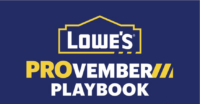
As Lowe’s PROvember returns, PROvember Playbook helps Pros ease burden of inflation with long-term savings, intel from industry experts and new survey findings Lowe’s will host a free Pro Happy Hour on Nov. 17 from 2 to 5 p.m. at all stores nationwide, where Pros can join in for free PEPSI drinks and FRITO-LAY snacks and more. MVPs Pro Rewards members can Read more
As Lowe’s PROvember returns, PROvember Playbook helps Pros ease burden of inflation with long-term savings, intel from industry experts and new survey findings
Lowe’s will host a free Pro Happy Hour on Nov. 17 from 2 to 5 p.m. at all stores nationwide, where Pros can join in for free PEPSI drinks and FRITO-LAY snacks and more. MVPs Pro Rewards members can also enter for a chance to win a trip to the NFL Pro Bowl Games.
The Pro Happy Hour comes amidst the return of Lowe’s PROvember, which is happening now through Dec. 8 online and in-stores to celebrate Pros, offer great savings and prep for the year ahead.
As Pros balance planning for another busy year ahead with closing out their winter project logs, Lowe’s is stepping in as a true business partner to help them find new opportunities to maximize their business. Enter: Lowe’s PROvember Playbook, a guide for Pros of all business sizes to create the most value as they restock and recharge heading into 2023.
According to new proprietary research from Lowe’s1, 86 percent of Pros found inflation a top challenge in 2022, and two-thirds of those Pros believe it will be a long-term issue. The Lowe’s PROvember Playbook will help ease the burden of such issues by offering advice from Lowe’s Pro Ambassadors about making the most with their money, which tools are worth stocking up on now, and which deals provide the most return on investment for their business.
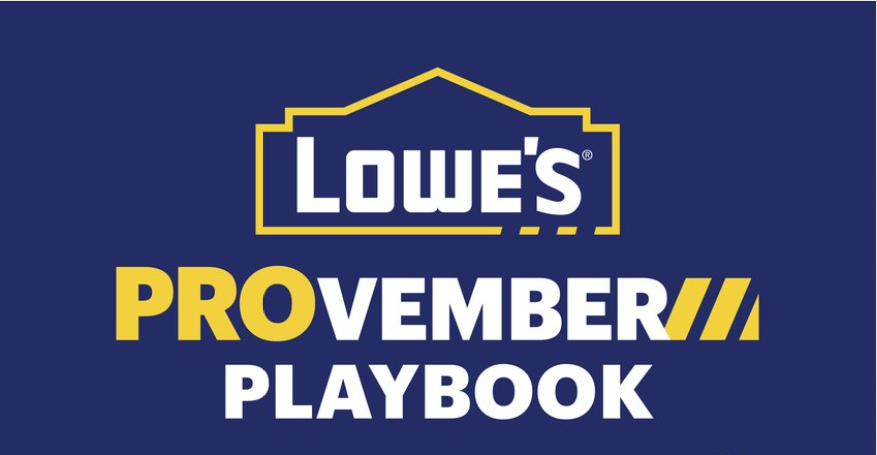
Available at Lowes.com/PROvemberPlaybook, the guide comes just as Lowe’s kicks off Lowe’s PROvember on Oct. 27, with more than 30 days to celebrate Pros—this year, with new upgrades to help Pros make the most of their year-end purchases, including:
- Extra savings to help provide more return on investment in the long run. In addition to immediate cost savings, Pros can stock up for the year ahead on select Pro-grade tools and materials—from DeWalt, Metabo HPT, FLEX and more—that also promote maximum productivity on the jobsite.
- Opportunities to earn rewards and celebrate their crew. MVPs Pro Rewards and Partnership Program members can rack up Bonus Points by earning up to three Bonus Points per dollar2 on select items during Lowe’s PROvember. And, Lowe’s will host a free Pro Happy Hour on Nov. 17 from 2 to 5 p.m. at all stores nationwide, where Pros can join in for free PEPSI® drinks and FRITO-LAY® snacks and more. MVPs Pro Rewards members can also enter for a chance to win a trip to the NFL Pro Bowl Games3.
- All this in addition to a Pro desk with fully dedicated Red Vest associates trained to help Pros, inventory quantities that Pros can count on and strong credit offerings (Pros can save five percent off every day on eligible purchases plus zero percent interest for 60 days when using the Lowe’s Business Advantage Account4).
“We know Pros have a lot of challenges to navigate this winter, so we are deepening our dedication through Lowe’s PROvember,” said Tony Hurst, senior vice president, Pro, services and international. “As a true business partner for Pros, we are listening to their needs and adding more value and more meaning to what we offer our Pros so they can get ahead of another busy year.”
For the second year in a row, Lowe’s conducted its proprietary Pro Pulse Survey1 to understand Pros’ reflections on the year and what they expect ahead. In addition to challenges they faced like inflation, the key findings suggest:
- Pros remain optimistic despite a challenging economic backdrop. Nearly three in five (59 percent) Pros say their job has been more challenging than last year, but 73 percent say their job has been more rewarding than last year.
- Pros expect steady project growth in 2023. 66 percent expect to have more work for the remainder of the year than they did during the rest of the year – and 73 percent expect even more work in 2023.
- The increasing economic pressures provoke an even deeper focus for Pros on saving time and money. While 98 percent of Pros say effective time management is important to the success of their jobs, 57 percent of Pros name effective time management as a challenge.
Looking ahead to next year, the majority of Pros (61 percent) plan to outsource part(s) of their business. Further, 68 percent say they rely on their retailers and suppliers more than they did a year ago.
Learn more about Lowe’s PROvember and shop the latest savings from Oct. 27 – Dec. 8 at Lowes.com/PROvember.
- TRUE Global Intelligence, the in-house research practice of FleishmanHillard, fielded an online survey of 1,000 home improvement professionals in the U.S. aged 18 and older between September 15 and 28, 2022, on behalf of Lowe’s.
- Program subject to Terms & Conditions. Details at Lowes.com/L/ProLoyaltyTerms. Subject to change. Bonus Points calculated before taxes and fees, after applicable discounts, if any.
- NO PURCHASE NECESSARY. Begins at 2:00:00 p.m. local time & ends at 5:00:00 p.m. local time on 11/17/22 (“Sweepstakes Period”). Open to legal U.S. residents residing in the 50 US/DC, 18 or older (19 or older for AL & NE) & a Lowe’s MVPs Pro Rewards member at the time of entry. Void where prohibited. Ends at 5:00:00 p.m. local time on 11/17/22. See Official Rules for free entry via email at bit.ly/3BZK3mC. Sponsor: Pepsi-Cola Company. Lowe’s is not a sponsor of this sweepstakes. The NFL Entities have not offered or sponsored this Sweepstakes in any way.
- For more information on Lowe’s PRO Financing Solutions options visit lowes.com/businesscreditcenter.

If you’re a plumbing and heating contractor who has been told by your distributor that all PEX F1960 expansion fittings are the same, be forewarned. That is simply not true. And the differences in low-quality F1960 fittings can come with considerable risk to your installations and your reputation. Pioneered by Uponor in 2000 through the Read more
If you’re a plumbing and heating contractor who has been told by your distributor that all PEX F1960 expansion fittings are the same, be forewarned. That is simply not true. And the differences in low-quality F1960 fittings can come with considerable risk to your installations and your reputation.
Pioneered by Uponor in 2000 through the design and development of their proprietary ProPEX® connection system, ASTM F1960, Standard Specification for Cold Expansion Fittings with PEX Reinforcing Rings for Use with Cross-linked Polyethylene (PEX), was the result of a collaboration between Uponor and the American Society for Testing and Materials (ASTM) international standards organization to provide a better solution for connecting PEX in plumbing, fire safety, radiant heating and cooling, and mechanical piping systems.
With the popularity of PEX continuing to grow in residential and commercial construction, a recent influx of engineered polymer (EP) F1960 expansion fittings have flooded the market claiming to be “just the same as ProPEX”. However, the industry needs to be aware that some manufacturers and suppliers are offering a lower-quality product that can put a system at significant risk for leaks or poor performance.
Understanding Certification vs. Compliance
ProPEX® fittings are certified by a third-party agency, NSF International, to prove the product is designed and manufactured to the ASTM F1960 standard. In addition, ProPEX fittings also include additional internal quality testing that extends beyond ASTM F1960 standard requirements to provide a higher-quality product.
Some suppliers claim their fittings are compliant to F1960, which means, in their opinion, they meet the standard. However, there is no third-party agency to confirm that compliance. This confusion between certification and compliance is resulting in PEX piping installations with lower-quality connections that are putting systems at risk for failure and jeopardizing installers’ reputations.
So, what happens when a third-party agency isn’t involved to keep manufacturers and suppliers in check? A random sampling of these lower-quality F1960 EP fittings revealed a reduced internal diameter (up to 50% in some instances), which restricts flow and limits system performance. Additionally, Uponor has begun to receive claims for failed connections that, after investigation, were found to be different suppliers’ low-quality F1960 fittings.
Contractors need to be vigilant when ordering and purchasing PEX expansion fittings to ensure they are actually getting ProPEX to help keep their installations strong and their reputations solid.
Here are some important physical attributes to look for when purchasing ProPEX fittings at your local distributor.
Manufacturer Name and Material Designation
The most obvious way to ensure you have a ProPEX fitting is by checking for the Uponor logo. Some older ProPEX fittings may have a “W” on the fitting instead, which stands for Warnock Hersey (another third-party certification) or Wirsbo. Anyone who has been in the industry for a couple of decades will recognize Wirsbo as the original company name of Uponor from 1984 to 2006.
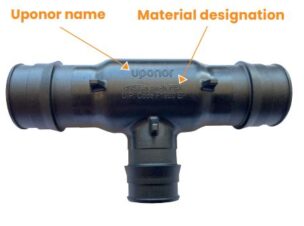
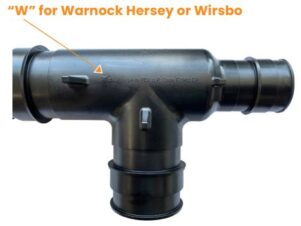
Quality Control Markings
ProPEX fittings are a highly engineered product, and Uponor manages the manufacturing source for every part to ensure product is produced to consistent manufacturing standards. In fact, the companies that mold ProPEX EP fittings are partners that are integrated into the codes.
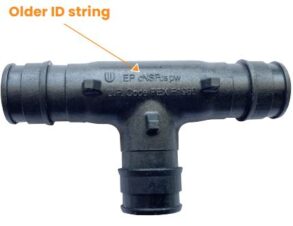
Thicker Tube Stops and Wider Sealing Barb
After more than 30 years of testing and refining the fitting design, ProPEX products feature thicker tube stops on the face of the fitting along with wider sealing barbs that create a stronger connection.
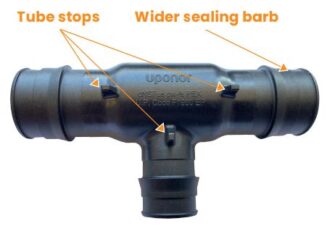
Other F1960 Fittings
Easy identification of other F1960 fittings include a different supplier logo and specific resin callout as well as thin, square tube stops near the base of the fitting, a thinner sealing barb, and only the size marking on the back. The thin tube stops are especially problematic as the expanded PEX pipe can extend past the stops and cause leaks.
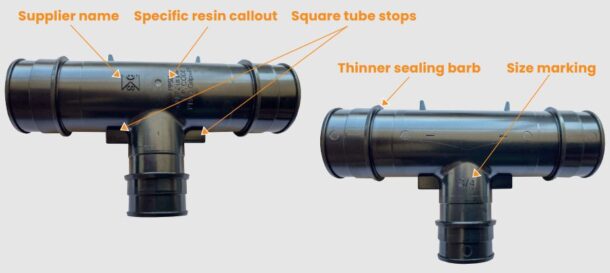
The Right Tools
While some may feel using any expansion tool will do the job, the tool you use actually does make a difference in the quality of the connection. Milwaukee® ProPEX® M12™ and M18™ expansion tools have been designed to Uponor’s specification and performance requirements with Uponor PEX-a pipe and ProPEX expansion rings as a system. Making a connection with Uponor PEX-a pipe, ProPEX rings, and ProPEX fittings using a different tool can, in fact, compromise the quality of the connection.
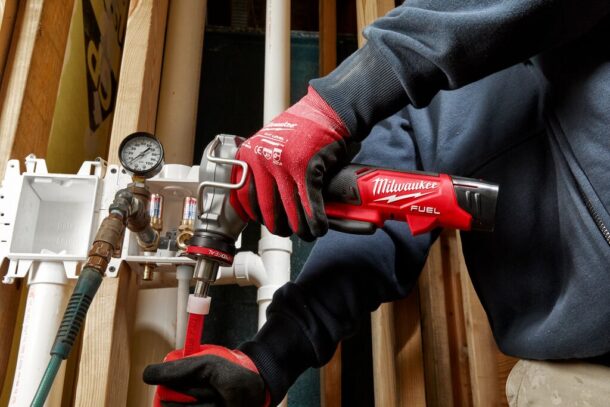
A Complete System and Solid Warranty
Lastly, ProPEX connections are part of a complete system that includes pipe, rings, and fittings. In fact, The Canadian Standards Association (CSA) tested and listed the system, which includes Uponor PEX-a pipe, Uponor ProPEX rings, and Uponor ProPEX fittings, and Uponor is the only brand to have this CSA system certification.
Installing a complete system comes with valuable benefits, such as a 25-year transferable limited warranty for added confidence in a solution that is designed and manufactured to last. Many generic F1960 fittings have limited warranties — some are as little as one year. And, if the fitting is used with a different manufacturer’s PEX pipe or expansion rings, there could be a question around who is liable for the claim. You don’t want to be caught in the middle of that dilemma!
Simply put, keep your installations solid and your reputation strong by ensuring you’re getting the right parts from your distributors and installing a complete system covered by one warranty holder. Don’t take the risk with low-quality products that won’t cover you when you need it.
 Kim Bliss is the technical and marketing content manager at Uponor. She can be reached at kim.bliss@uponor.com.
Kim Bliss is the technical and marketing content manager at Uponor. She can be reached at kim.bliss@uponor.com.

The Lowe’s MVPs Pro Rewards and Partnership Program is a new approach that flips traditional loyalty programs on their heads to deliver real solutions and benefits Pros need to succeed. The new program comes at a time when 90% of Pros say it’s important that retailers have valuable loyalty programs, and according to new findings from Lowe’s, Pros also voiced Read more
The Lowe’s MVPs Pro Rewards and Partnership Program is a new approach that flips traditional loyalty programs on their heads to deliver real solutions and benefits Pros need to succeed. The new program comes at a time when 90% of Pros say it’s important that retailers have valuable loyalty programs, and according to new findings from Lowe’s, Pros also voiced the need for retailers to bring more than rewards to the table.

Lowe’s MVPs Pro Rewards, available in select regions and nationwide gives Pros a committed business partner in Lowe’s. Complementing Lowe’s strong credit offerings (5% off every day on eligible purchases, to 0% interest for 60 days for Lowe’s Business Advantage accounts), Lowe’s MVPs Pro Rewards offers new and existing loyalty members benefits including:
- Lowe’s e-gift cards earned when Pros spend in-store and online on eligible purchases**
- Access to business resources helping Pros tackle back-of-house operations
- Exclusive offers for rewards on eligible paint purchases** and free select snacks or drinks** at Lowe’s stores
- A chance to win incredible prizes like Ford F-Series trucks that serve as many Pros’ mobile offices and custom-built local advertising packages***
- A simple mobile and online user experience allowing Pros to track and claim rewards even when sending a crew member into the store
- And, coming soon, MVPs Bonus Points that can be used for additional exciting rewards helping Pros invest in their businesses and themselves
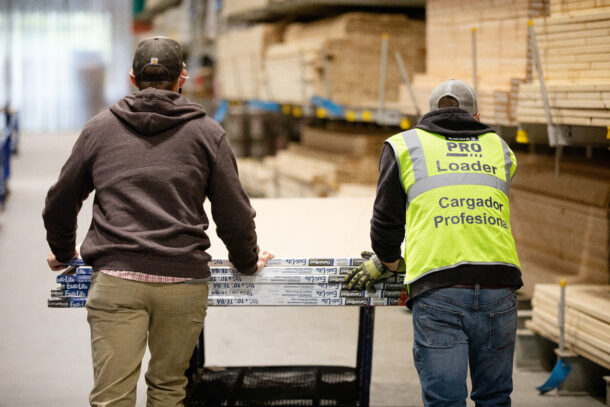
“We’re deepening our partnership with Pro customers because when they succeed, we succeed,” said Tony Hurst, Senior Vice President Pro, Services and International. “Lowe’s MVPs Pro Rewards is another big step in Lowe’s continued Total Home strategy when it comes to the important Pro customer. We are committed to a true business partnership mindset to help Pros as they grow their businesses and their futures.”
Nearly 90% of Pros say it’s important for retailers to have valuable loyalty programs as Pros also voiced the need for retailers to offer solutions to propel their business forward, according to Lowe’s first annual Lowe’s State of the Pro report, found online at Lowes.com/StateOfThePro. An industry-leading study, the report contains insights from Pros and their customers, detailing the state of the home industry and trends in homeowner improvement plans, and priority projects in 2022.
For more information on the latest for Pros, please visit Lowes.com/Pro.

As the effects of climate change become more apparent, humanity faces growing pressure to use more renewable and eco-friendly energy sources. The electric vehicle is one step in the right direction, as millions of people worldwide now own an EV. This new technology is also making its way into our business operations in the form Read more
As the effects of climate change become more apparent, humanity faces growing pressure to use more renewable and eco-friendly energy sources. The electric vehicle is one step in the right direction, as millions of people worldwide now own an EV. This new technology is also making its way into our business operations in the form of electric service vans.
Could electric vans be the service machines of the future? What obstacles might arise from implementing them into the workforce? Here’s everything you need to know about the future of electric service vehicles.

The Growth of Electric Service Vehicles
EV development has taken some big steps in recent years. A group of major companies – including Amazon and AT&T – established the Corporate Electric Vehicle Alliance (CEVA) in 2020, which marked a significant step in moving the economy towards renewable energy sources.
The alliance sent a clear message that electric vehicles are here to stay. It increased the demand for EVs and put greater pressure on auto manufacturers to ramp up production. Many big-name brands have released numerous electric models to meet the growing demand. We have also seen startup EV companies like Rivian gain relevance.
Contractors, engineers, maintenance professionals, and other occupations that rely on gas-powered vehicles should prepare to make the switch. If the CEVA alliance and increased EV production weren’t enough incentive, customers might also expect you to switch. They’re more environmentally aware than ever and have higher buying standards. EVs would help you build a positive brand image for this new wave of consumers.
Though it may seem intimidating now, transitioning to electric could bring your vehicle-reliant organizations to new heights. Businesses constantly look for new methods to make their operations more efficient, and electric vehicles improve efficiency in several ways:
- Charging costs less than refueling.
- Electric motor maintenance is less expensive and time-consuming.
- EVs are lighter than traditional vans and have better acceleration.
- They do not emit pollutants.
These benefits make switching to electric service vehicles seem like a no-brainer, but things aren’t as black and white as they appear. We have to overcome some serious obstacles to successfully bring fleets of EVs onto the roads.
Roadblocks Lie Ahead
While EVs have undeniable advantages over gas-powered vehicles, our infrastructure does not have the space or stability to handle widespread EV implementation. These are the primary issues with our current situation:
- Charging Stations: We would have to build thousands of charging stations to keep up with an influx of EVs, but the cost of installation and maintenance is a significant investment. Additionally, there are few logical locations for these stations that allow drivers to charge their vehicles without disturbing their schedules or privacy.
- Power Grid Workload: Our current power grid cannot sustain increased EV adoption in the long term. We would have to invest in a larger grid infrastructure or risk overloads and power outages.
- Grid Emissions: Although EVs themselves don’t cause pollution, grey electricity grids rely on fossil fuels. The more we use EVs, the more emissions we indirectly cause. We must find a way to decarbonize the grids.
With these issues in mind, skeptics wonder if the transition to electric is even worth the hassle. However, advances in Internet of Things (IoT) technology and artificial intelligence (AI) could introduce smarter methods of charging, grid load management, and battery maintenance in due time.
The success of electric vehicles depends on continuous progress in AI and IoT. Our infrastructure alone cannot withstand a massive influx of electric vehicles. Implementation remains a slow work in progress for now. Although millions of EVs have made it onto the road, companies are still holding off on rolling out EV fleets.
Progress Is Slow, but Remain Vigilant
Electric vehicles could play a major role in a greener future, but they also threaten our infrastructure’s stability. Even with these looming obstacles, corporations seem intent on making the switch. You should stay alert for sudden advancements, no matter how slow things appear right now.
Prepare yourself by researching the various electric service vehicle models and outlining how you would integrate them into your business operations.

